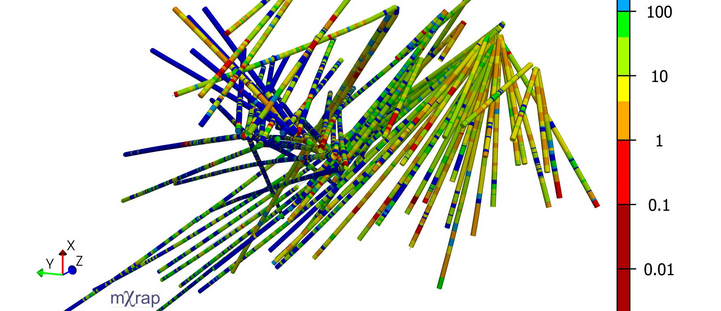About the Rock Mass Data Analyser
- Rock mass quality data (e.g. RQD, RMR, Q, Q’, GSI, etc.)
- Structural data (i.e. joint orientations and joint conditions from scanline mapping and logging data)
- Laboratory test results (e.g. UCS, TCS, and BTS)
Once geotechnical data has been imported, there are multiple filter options available for borehole IDs, lithologies, data sources, joint sets, and rock strength test types. Pre-set legends for all geotechnical data are also provided within the app, as well as the ability to select and filter data based on 3D locations. Histograms and CDF curves of rock mass quality data are also available for the various lithologies and boreholes in the database. These lithologies may be combined or plotted separately. The ability to select data based on 3D location also provides the user the opportunity to create histograms for a specific geotechnical domain or area of interest. Both scanline mapping data and borehole structural logs can be imported and viewed in 3D and on stereonets. Once structural data is imported, the user has the option to assign discontinuity sets on stereonets. As sets are assigned or as filters are applied, real time updates to discontinuity set statistics are provided. For intact strength laboratory test results, along with visualisation of the test result locations along boreholes, Hoek–Brown failure envelopes can be produced for specific lithologies, a group of data or for specific boreholes. The RMDA is also integrated with mXrap’s discrete fracture network (DFN) generation app and our data collection web app (which allows for efficient scanline mapping with the use of a tablet). Currents plans for the RMDA include the development of a section for the creation and analysis of geotechnical and structural domains and for the analysis of window mapping and point load test data. The RMDA will also act a feeder app into the stope reconciliation and geotechnical block model applications, which are currently under development.


Rock Mass Data Analyser Video Library
See the suite in action and access training resources on mXvideos.
Details
Principal author: Denisha Sewnun
Contributing authors: Daniel Cumming-Potvin, Johan Wesseloo, Kyle Woodward
Related Blog Posts

Hazard Assessment – Event Rate

RMDA app: new geotechnical domains delimiter app and more!

Rock Mass Data Analyser updates



